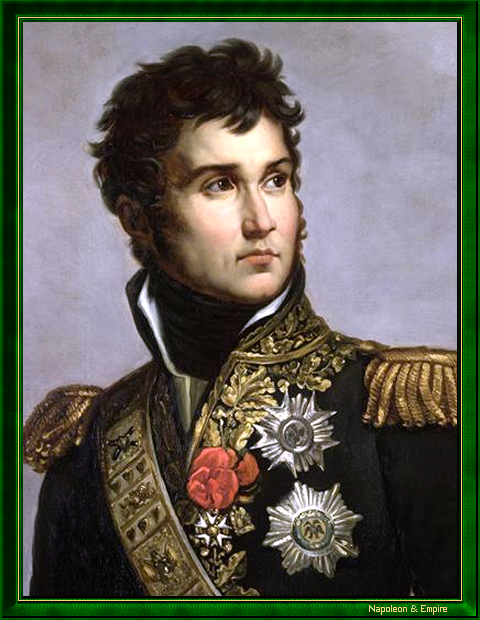Duke of Montebello
Pronunciation:

Jean Lannes was born on April 10, 1769 in Lectoure
When the Revolution began, Lannes was a dye worker and enlisted in 1792 in the 2nd Battalion of Volunteers of Gers. His distinguished himself early on by his exceptional courage and was made a captain the next year.
After fighting the Spanish between 1793 and 1795, he was sent to the Italian army in November of that year after the peace agreement with Spain was signed.
He fought at Millesimo, at Dego (where Bonaparte noticed his passion for battle) and at Lodi after having been the first to cross the Po river at the head of his brigade. His less commendable activities proved that together with courage, he possessed another essential quality of a good soldier: discipline. On May 25, 1796, he carried out the order to set fire to the village of Binasco without batting an eye and on June 1st he put down the revolt in Arquata. In September 1804 he was promoted to Brigadier General.
He fought in all the battles in Egypt, with particular success at El Arich (February 20, 1799) and Jaffa (March 7). By the end of the campaign he was a général de division (Major General)
He returned to France with Napoleon Bonaparte and supported the latter's coup d'état by rallying the infantry officers stationed Paris to the cause which many joined. Over the course of the coup d'état of 18 and 19 Brumaire, Year VIII (November 9-10, 1799), Lannes was in command of the Tuileries headquarters and did not actively take part in the events at Saint-Cloud. Two days later, he left the capital when he was assigned command of the 9th and 10th military regions (Toulouse and Perpignan) with the task of suppressing any opposition to the new regime. He returned six weeks later and replaced Joachim Murat at the head of the Consular Guard.
It was during the second Italian campaign of 1800 that he achieved his greatest successes. He took Aosta and Pavia, carried the day at Montebello and was awarded a Sabre of Honour for his resistance in the face of the Austrian attack at Marengo.
During 1801, Lannes found himself in the middle of a delicate financial situation. As the commander of the Consular Guard, his excessive spending left the regiment's account 300 000 francs in the red. To make matters worse, the First Consul categorically denied having authorized such expenses. Lannes was ordered to personally cover the shortfall within a very short time-frame or face a court martial. Despite having had plenty of opportunities to acquire considerable wealth during his campaigns, Lannes did not possess the sum required and was unable to meet the deadline. He was finally saved by General Augereau who loaned him the money. This lost him his command on November 14 and on the same day he was sent to Portugal as a minister plenipotentiary which was effectively a demotion.
Disgraced, he arrived at his embassy in March 1802 where he would not thrive due to his poor diplomatic skills. He did not get along with the British ambassador, who had been enjoying good relations with the French, nor with the Portuguese government who accused him of being in the pay of the British. Moreover, his ongoing attempts to obtain 300 000 francs placed him in an unpleasant situation given the state of his relations with the Portuguese authorities. A complaint was sent to Paris and Charles-Maurice de Talleyrand, who hated Lannes's mercurial personality and quick temper, seized the opportunity to make his views known to Bonaparte. Appalled, Lannes left his posting without authorization in August. He was sent back in March 1803 and only returned to France in August 1804 after signing a treaty with Portugal obtained under threat of an invasion.
In the mean time, Jean Lannes had been made one of the first Marshals of the Empire in 1804. That same year, he bought the château de Maisons
In 1805 he took command of the 5th corps of the Grande Armée. As part of the vanguard, he took Ulm, Braunau, entered Vienna and fought at Hollabrunn on November 16. During the Battle of Austerlitz he was in command of the left flank. Five days later he left the army for unknown reasons and the command of the his corps to Marshal Lefebvre.
He returned the next year for the Prussian campaign. He was the victor at the Battle of Saalfeld on October 10, 1806 where Prince Louis-Ferdinand of Prussia died. He also commanded the centre at Jena and was given the task of pursuing the Prussians into Poland by Napoleon. This led to the confrontation with Russian army at Pultusk on December 26. In 1807, he intervened during the capture of Dantzig and at Heilsberg and command the centre once again at Friedland.
In 1808, Napoleon I made him the Duke of Montebello before sending him to Spain where he fought the regular Spanish army at Tudela on November 23. He was also in charge of the siege of Saragossa which ended with the capitulation of the city in February 1809 after a heroic but desperate resistance by its citizens.
By April of the following year he was again assigned to the German Army. He fought at Abensberg (April 20), Landshut (April 21), Eckmühl, the capture of Ratisbonne and at Aspern-Essling.
Toward the end of the day after the Battle of Aspern-Essling, he was walking with his friend and mentor General Pierre-Charles Pouzet (and not Rouzet as the name is often spelled) when Pouzet was struck by a bullet and died instantly. Overcome by grief, the Marshal sat down at the edge of a ditch where a piece of shrapnel cut through his thigh effectively ended his military career. By chance or foresight, he was wearing his full uniform complete with decorations and medals. Despite a swift and competent amputation performed by Dominique-Jean Larrey, Lannes died in agony ten days later (May 31) at Ebersdorf in a brewer's house after a visit from the Emperor in his final hours.
"Marshal Lannes, Duke of Montebello (detail)" by Julie Volpelière (Marseille 1790 - Paris 1842), after François Antoine Gérard (1760-1843).

Though he was known for his exceptional courage, Lannes did not enjoy war despite being called the Roland of the army and having been often wounded (at Governolo in 1795, at Arcole two months later, at Acre and at the Aboukir Fort in 1799, and at Pultusk in 1806). He is said to have told his personal doctor, I fear war and I have told the Emperor. The first sounds of a battle make me shiver, but once I have taken the first step forward, I think of nothing but the task at hand.
Jean Lannes de Montebello was buried
The Postal Service of the Republic of France released an 0.50 franc stamp bearing the image of Jean Lannes
His name can be found on the 13th column (east side) of the Arc de Triomphe

